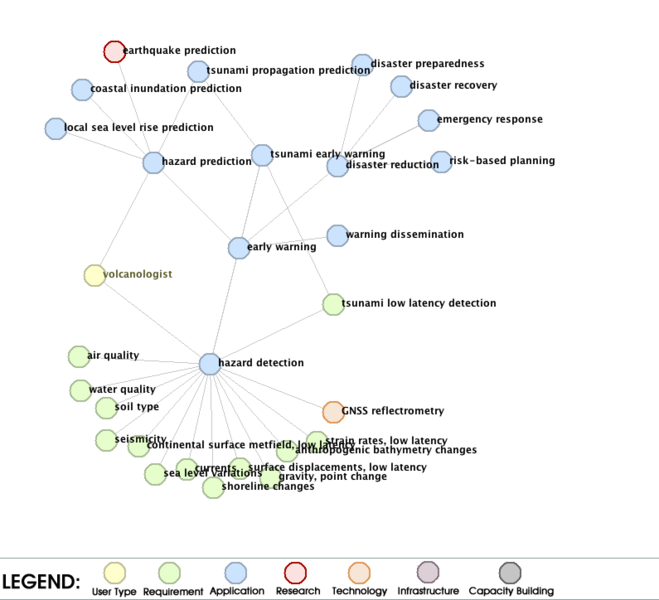
|

|

Tutorial Home | Site Map | Glossary | GEOSS URR | GEO |
|
| Early Warning: Starting Extending Adding Details Completing Analysis | Previous Next |

|
Completing the Local Environment As the environment of 'Early Warning' develops, the picture becomes increasingly complex. The current version of the URR allows to explore the environment graphically. This tool is very helpful to visually assess the development of a local environment as more entries are published, and it should be used extensively to iterate the entries in the local approach. Frequent looks at the graphics helps to see whether the local environment is making progress towards completeness. Using 'Early Warning' as the starting point, the graphics displays all other URR entries linked to 'Early Warning,' as well as all entries linked to these entries in a second level (see the glossary for the definition of link level and link degree). In the graphics shown, we can see that on first level, 'early warning' is linked to hazard detection, hazard prediction, and warning dissemination, which are the applications mentioned earlier. We also see a link to disaster reduction. Currently, the links do not show the directionality of the connection. Hazard detection, hazard prediction, and warning dissemination are part of early warning, and the Links entries in the URR use the former as source and early warning as the target entry. Early warning is part of disaster reduction, and consequently early warning is the source and disaster reduction to target in the associated Links entry. We notice that the application warning dissemination has not been broken down into sub-applications yet. Thus, the graphics is indicating the need for further entries giving more details of warning dissemination. The user type volcanologist has been linked to both hazard detection and hazard prediction. Of course, there are many more user types that are linked to these to applications, but these have not yet been published or the links have not been established. Once an environment is completely captured, the current graphics easily might get overpopulated. In the future, it will be possible to constrain the entries shown to, for example, only applications, or only application and research needs, or any other selection. There is also an application tsunami early warning, which is linked to the requirements for tsunami low latency detection and the application tsunami propagation prediction. It is also linked to the more general application of early warning. This example illustrate the complexity of links. In the example, the connection between hazard detection and tsunami early warning is through the requirement tsunami low latency detection, while the connection between tsunami propagation prediction and tsunami early warning is through a direct link. We could have made the choice to link tsunami propagation prediction to a (output) requirement for tsunami prediction, and then link this requirement to tsunami early warning. In general, preference should be given to the alternative that explicitly describes the requirements, and thus visualize the flow of information between different applications. |